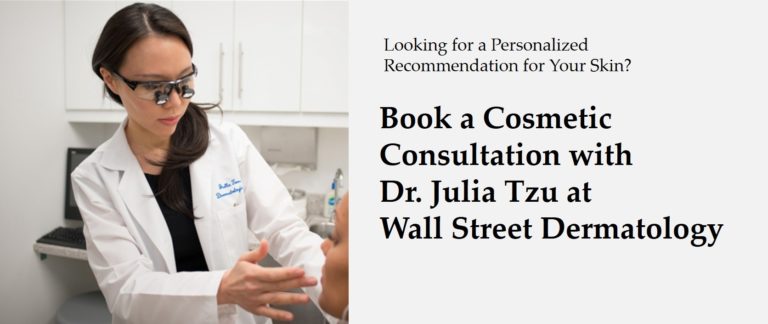Fill Indentations & Fade Scars: Atrophic Scar Treatment NYC
Proper technique and exquisite attention to detail to repair your skin
- Last Updated: December 6, 2024
- By: Julia Tzu, MD FAAD
Atrophic Scar Removal at Wall Street Dermatology
Do you want to treat your atrophic scars? Wall Street Dermatology is a cosmetic, surgical, and laser dermatology private practice that provides scar revision in NYC. Dr. Tzu is a double-board certified dermatologist in NYC with years of experience and expertise in atrophic scar treatment in NYC.
Atrophic scars occur when your skin is unable to regenerate sufficient collagen and results in an indentation. These skin indentations can result from traumatic, acne, surgical, or chickenpox scars. While some scars may undergo some level of fading, atrophic scars are particularly stubborn and don’t resolve over time. Atrophic scar treatment helps fill in the indentation and fade the appearance of your previous wound for a smooth, balanced appearance.
If you want to talk to a professional dermatologist about atrophic scar treatment, call Dr. Tzu today at 212-931-0538.
Types of Atrophic Scars
Many forms of trauma to the skin can cause indented or atrophic scars. Below are the most common causes of atrophic scars.
Atrophic Acne Scars
Acne that affects the deeper layers of the skin, often cystic acne, damages the tissue beneath. This results in multiple types of atrophic acne scars, including ice pick, boxcar, and rolling scars. Ice pick acne scars are sharp v-shaped indentations that look like holes in the skin. Boxcar acne scars look like an inverted plateau and can be shallow or deep. Rolling acne scars are similar to boxcar scars but with rounder, wider impressions in the skin. This gives the skin a rolling texture. At Wall Street Dermatology, we provide acne scar treatment to get rid of these unsightly scars on the face.
Traumatic Scars
Traumatic scars result from injuries such as burns, scrapes, cuts, or penetration of sharp objects. While some traumatic scars can be hypertrophic, atrophic scars are most common, especially with injuries with tissue loss.
Postoperative Scars
Postoperative scars are scars that result from a previous procedure. Some common surgical procedures that result in atrophic scars include skin cancer surgery, lipoma removal, cyst removal, laser mole removal, and biopsy scars.
Chickenpox Scars
Having chickenpox doesn’t always lead to scarring. However, if you scratch and over traumatize the skin, it is likely to result in atrophic scars. Chickenpox may happen all over the body, including the face, which means you can have extensive scarring.
“The majority of my work on a daily basis deals with minimizing scarring when performing a surgery or other invasive skin procedure. This has led to a profound experiential understanding and appreciation of scars and how to optimize scarring outcomes. One of my favorite procedures is scar revision/reduction because it invokes the knowledge, surgical skill, and experience that is the very nature of my daily work and passion. I am honored to be part of the journey that allows people to erase and forget their past scars.”- Dr. Julia Tzu, MD, FAAD
Benefits of Atrophic Scar Treatment
Atrophic Scar removal has many benefits if you are frustrated with your appearance and want a reliable solution. There are many types of atrophic scar treatments, including laser treatment, surgical scar removal, subcision, and microneedling. While each cosmetic procedure is different in its approach to atrophic scars, they all help to fill in the indentation of skin, fade discoloration, or reduce the overall appearance of scarring.
Atrophic Scar Treatment Cost
Atrophic scar treatment in NYC can vary depending on the type of cosmetic procedure you choose, the extent of the scarring, and the size of your treatment area. A typical atrophic scar treatment can cost anywhere from $550 to $2,500 per session. You may need multiple sessions to reach your desired cosmetic results.
How to Treat Atrophic Scars
Depending on the severity of your atrophic scars, Dr. Tzu may recommend one of three scar treatments. Each is different in its invasiveness, price, procedure, and recovery. We outline each cosmetic procedure below so you can determine which one is right for your atrophic scars.
Scar Subcision
Scar subcision is a highly effective atrophic scar treatment in which a fine sharp instrument is tunneled under scar tissue to break apart vertical strands of scar tissue that binds the surface of the skin down. Subcision creates a matrix of tunnels under the skin that releases the indented surface, so that the skin is lifted up and flattened. At the same time, injectable cosmetic filler material can be simultaneously injected into the tunnels to help support the newly elevated skin. The body gradually creates collagen in the newly subcised tissue to eventually replace the injected filler and regenerate the skin.
Microneedling
Microneedling uses tiny needles known as “micro” needles that penetrate the skin and stimulate collagen production. These small pricks of the skin promote the body’s natural healing process to create collagen and fill in scar tissue. Not only will microneedling fill in collagen for the atrophic scar, but it will also improve the skin’s overall color and texture. It can be used alone or in combination with subcision treatments.
Scar Revision Surgery
This atrophic scar treatment is more invasive than subcision or microneedling, but it’s best suited for more severe atrophic scars. Scar revision surgery reduces the appearance of scars by removing the scar tissue and replacing it with a less visible scar. This type of atrophic scar treatment in NYC helps smooth and blend the skin for a more balanced appearance. If you have postoperative scarring, scar revision surgery is the best scar treatment option for you.
Schedule a Consultation at Wall Street Dermatology
To discuss what type of atrophic scar treatment is best for you, schedule a consultation with Dr. Tzu. We look forward to exploring how we can restore the natural beauty of your skin.
Atrophic Scar Treatment FAQs
The best scar treatment for your atrophic scar depends on the severity of your indentation. Scar revision surgery is for the most severe scars. Subcision and microneedling can both treat acne scars, postoperative scars, and chickenpox scars. Schedule a consultation with Dr. Tzu to discuss which atrophic scar treatment in NYC will achieve your cosmetic desires.
The results from your scar revision surgery are permanent. However, you may need multiple sessions of subcision treatment and microneedling to see your desired results. You may need follow-up cosmetic procedures to continue to sustain the results of your subcision or microneedling treatment.
You may need an average of four to six sessions of subcision or microneedling to have the full impact on your atrophic scar. However, if you choose scar revision surgery, you’ll need fewer treatment sessions compared to subcision or microneedling.
You may notice an improvement to your atrophic scar immediately following your scar treatment. However, for the full results of your cosmetic procedure, you may need to wait a few weeks to months for the skin to go through its full healing process.
You can get subcision scar treatment, microneedling, and scar revision surgery in most places on the body where you have atrophic scars. However, many of these cosmetic procedures are more commonly used to treat the face, where scarring is more of a concern.


